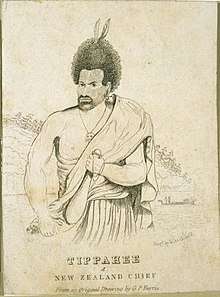Te Pahi

Te Pahi (Tippahee in traditional orthography) (?–1810) was a Māori tribal leader and traveller from New Zealand. He was from the Ngāpuhi iwi and lived in the Rangihoua Bay area of the Bay of Islands.[1]
In 1805 Te Pahi was the first influential Māori leader to visit Port Jackson (Sydney) where he met Samuel Marsden, chaplain of New South Wales.[1] Te Pahi attended church services and discussed religion with Marsden, who formed plans for a Church Missionary Society mission under Te Pahi's protection at Rangihoua.[1]
In 1806, during his visit to Port Jackson, Te Pahi met New South Wales Governor Captain Philip Gidley King, who presented him with a medal to recognise his visit. It was the first State gift presented to a Māori rangatira. King also presented Te Pahi with a prefabricated brick house which was built in his pā on Motu Apo Island and was the first permanent European style house in New Zealand.
Te Pahi was incorrectly blamed for the burning of the Boyd incident in 1809[2] and his pā on Motu Apo was stormed by crew from several whaling ships in retaliation in 1810. The whalers murdered many people, looted the island and destroyed houses including the gift from King.
Te Pahi was wounded in the attack on his island but his death several weeks later was as the result of other wounds he received in a conflict with Māori from the Whangaroa region over the Boyd affair.[1] He was succeeded as chief of the Rangihoua Bay area by Ruatara.
Stolen medal reappears
The silver medal presented to Te Pahi was stolen during the raid by the whalers in 1810, and its whereabouts remained unknown until 204 years later when an auction house in Sydney offered it for sale.
Ngapuhi representatives and Te Pahi descendants intervened to try to return the taonga back to New Zealand, and they negotiated with Te Papa and the Auckland War Memorial Trust who jointly purchased the medal. The medal was purchased at an auction in Sydney in 2014 and put on display at Te Papa in 2017.[3]
References
- 1 2 3 4 Ballara, Angela. "Te Pahi". Dictionary of New Zealand Biography. Ministry for Culture and Heritage. Retrieved 1 December 2011.
- ↑ Kendall, Thomas. "Thomas Kendall's Journal, 8 July 1815". Marsden Online Archive. University of Otago. Retrieved 27 May 2015.
- ↑ "Te Pahi medal on display at Te Papa". 19 May 2017. Retrieved 20 August 2017.